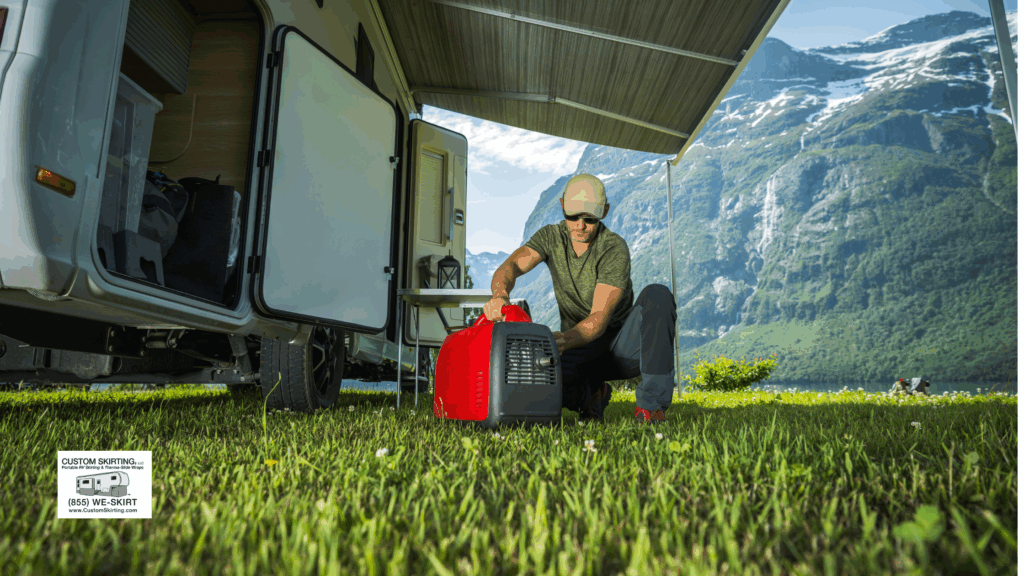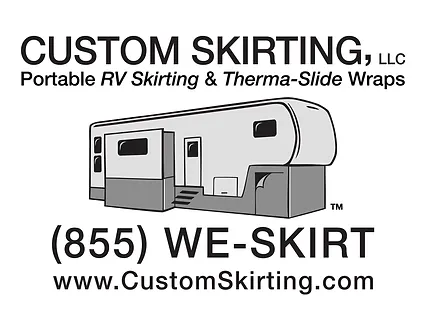
What Does an Inverter Do in an RV: Understanding RV Inverters
Table of contents
- Understanding Basic Electricity Concepts in RVs
- The Primary Function of an RV Inverter
- Types of RV Inverters
- Choosing the Right Inverter for Your RV
- Benefits of Having an Inverter in Your RV
- Inverters vs. Converters: Understanding the Difference
- Battery Technologies That Work Best With Inverters
- Integration with Solar Power Systems
- Real-World Examples of Power Consumption and Runtime
- Remote Monitoring and Smart Inverters
- Parallel Inverter Setups for High Power Needs
- Maintaining Your RV Inverter
- Upgrade Your Power—Maximize Efficiency with Custom RV Skirting!
- Related Articles
If you’re new to RV life or even a seasoned traveler looking to upgrade your setup, you’ve likely asked yourself: What does an inverter do in an RV? Or maybe you’re wondering: what is an RV inverter, how does an inverter work in an RV, or what is an inverter in an RV? These are important questions, especially for anyone who enjoys camping off-grid or wants to run household appliances on the road. In this comprehensive guide, we’ll break down exactly what does RV inverter do, how it works, and why it’s essential for modern RV living. At its core, an RV inverter allows you to use standard 120V household appliances by converting 12V DC power from your RV’s batteries into 120V AC power. This capability is especially valuable when you’re boondocking or traveling far from shore power hookups. With an inverter, you can brew your morning coffee, charge your laptop, or watch TV—all without being plugged into the grid. Let’s dive into the nuts and bolts of RV inverters.
Understanding Basic Electricity Concepts in RVs
Direct Current (DC) Power
In an RV, the primary power source when you’re not plugged into shore power is your battery bank. These batteries deliver 12V direct current (DC) power. DC power flows in a single direction and is used by essential RV systems like:
- Interior lighting
- Water pumps
- Vent fans
- Propane refrigerator control boards
However, DC power has limited use. You can’t plug your coffee maker or laptop directly into a 12V outlet and expect it to work. That’s where an inverter comes in.
Alternating Current (AC) Power
Most household electronics and appliances are designed to operate on 120V alternating current (AC) power. AC power alternates direction periodically and is the standard power type in homes and campgrounds. When you’re connected to shore power, your RV receives AC electricity directly. But when you’re camping off-grid, you need a way to convert the DC power from your batteries into usable AC power. Enter the RV inverter.
The Primary Function of an RV Inverter

DC to AC Conversion Process
So, how does an inverter work in an RV? An inverter draws 12V DC power from your RV’s battery bank and converts it into 120V AC power. This allows you to plug in and use appliances like:
- Microwaves
- TVs
- Laptops
- CPAP machines
Inverters accomplish this conversion through internal circuitry and electronic components. However, this process is not 100% efficient. On average, 5-15% of the energy is lost during the conversion. That means careful power management is essential to avoid quickly draining your batteries.
Power Limitations and Battery Drain
Running appliances through an inverter uses a lot of battery power. A 1000W microwave, for instance, might draw over 100 amps from your 12V battery system. This can deplete your batteries fast if you don’t have a robust power setup. Larger appliances like air conditioners often exceed the capacity of most RV inverters, and are best powered by shore power or a generator.
Types of RV Inverters
Pure Sine Wave Inverters
Pure sine wave inverters produce a clean, smooth wave that closely mimics utility-supplied electricity. These are ideal for sensitive electronics and appliances with motors, such as:
- Medical devices (e.g., CPAP machines)
- Laptops and smartphones
- Refrigerators
- Microwaves
Although more expensive, pure sine wave inverters provide reliable, stable power without the risk of damage to your electronics. For most full-time RVers or those who value high performance, they’re the best choice.
Modified Sine Wave Inverters
Modified sine wave inverters create a stepped waveform that works well for simple appliances like:
- Lights
- Toasters
- Blenders
However, some devices may overheat, make noise, or function improperly. These inverters are less expensive but come with limitations. If you’re on a tight budget and only plan to run basic equipment, this type might suffice.
Square Wave Inverters
Square wave inverters are outdated and rarely used in modern RVs. They produce very choppy electricity that can damage sensitive electronics. Their only use today might be in very basic setups, but they are generally not recommended.
Choosing the Right Inverter for Your RV
Determining Your Power Needs
To choose the right inverter, you must first calculate your total power requirements. Add up the wattage of all devices you plan to use simultaneously. For example:
- Coffee maker: 1000W
- Laptop: 60W
- TV: 150W
Total: 1210W. Add a 20% safety margin, and you’ll want an inverter rated at least 1450W.
Inverter Sizing and Capacity
Inverters come in various sizes, typically ranging from 1000W to 3000W. Here’s a quick guide:
- 1000W: Suitable for small RVs and minimal appliance use
- 2000W: Ideal for moderate appliance use (microwaves, TVs, laptops)
- 3000W: Great for larger RVs and heavier appliance use
Remember, your battery bank must also support the inverter’s demand. A 3000W inverter could draw 250+ amps from your battery bank, so you’ll need sufficient amp-hours available.
Installation Considerations
Proper inverter installation is crucial. Here are key points:
- Mount inverter close to the batteries
- Use heavy gauge wire for minimal voltage drop
- Install adequate ventilation
- Use proper fuses and disconnect switches
Remote monitoring panels or app-based control options can also be added for convenience.
Benefits of Having an Inverter in Your RV

Off-Grid Freedom and Boondocking
What does an inverter do in an RV when you’re boondocking? It allows you to enjoy electricity without being tied to shore power. Combine an inverter with solar panels and lithium batteries, and you’ve got a full-fledged off-grid system.
Convenience and Comfort
An RV inverter turns your camper into a mini home. Use your coffee maker in the morning, charge your devices, and stream movies—all without needing hookups. That’s the power of what does RV inverter do.
Backup Power Solution
Inverters also serve as a backup when shore power fails. Unlike generators, they operate quietly and can power essential appliances while driving or during brief outages.
Inverters vs. Converters: Understanding the Difference
What is an RV Converter?
An RV converter does the opposite of an inverter: it takes 120V AC power (from shore power or generator) and converts it to 12V DC to charge your batteries and run DC systems. Most RVs come with a built-in converter.
When to Use Each Device
Use an inverter when running AC appliances off-grid. How does an inverter work in an RV? It converts DC battery power into usable AC electricity. Use a converter when plugged into shore power to keep your battery charged. Some RVs feature inverter/charger combos, which combine both functions. These are becoming increasingly popular because they simplify the electrical system and ensure seamless transitions between power sources.
Battery Technologies That Work Best With Inverters
Lead-acid batteries (flooded or AGM) have been the standard, but lithium-ion batteries (LiFePO4) are now preferred for inverter setups. Why?
- Higher energy density
- Faster charging
- Longer lifespan
- Deeper discharge capabilities
Lithium batteries are ideal for inverters because they can handle high power draws without significant voltage drops, making them perfect for off-grid systems.
Integration with Solar Power Systems
Inverters are a vital component in solar-powered RVs. Solar panels charge your batteries, and the inverter converts that stored DC power into AC power. A smart solar setup includes:
- Solar charge controller
- Lithium battery bank
- Pure sine wave inverter
- Battery monitor and app
Together, they offer complete independence from shore power.
Real-World Examples of Power Consumption and Runtime
Let’s say you have a 200Ah lithium battery bank (usable ~160Ah) and a 2000W inverter. You want to run:
- Microwave (1000W) for 10 minutes = ~17Ah
- Laptop (60W) for 4 hours = ~20Ah
- TV (150W) for 3 hours = ~40Ah
Total consumption = ~77Ah. You’ll still have ~83Ah left—enough for lights and water pump overnight. These calculations help you plan effectively.
Remote Monitoring and Smart Inverters
Modern inverters often come with Bluetooth and Wi-Fi capabilities. Apps like VictronConnect or Xantrex Freedom let you:
- Monitor battery levels
- Turn inverters on/off
- View error logs
Smart inverters are great for tech-savvy RVers who want precise control over their power system.
Parallel Inverter Setups for High Power Needs
Need more than 3000W? Some inverters can be run in parallel. This allows you to double your output and power even the most demanding appliances. Parallel setups require:
- Identical inverters
- Synchronization modules
- Careful wiring
This is an advanced setup but valuable for luxury RVs or those with high-end equipment.
Maintaining Your RV Inverter
Regular Maintenance Tips
- Check all connections monthly
- Clean vents and fans
- Keep the unit dry and protected
- Watch for corrosion
Proper care ensures longevity and performance.
Troubleshooting Common Issues
- Inverter won’t turn on: Check battery voltage and fuse
- Overheating: Improve ventilation
- No AC output: Check for error codes and reset the unit
Consult your inverter manual for specific troubleshooting guides.
Upgrade Your Power—Maximize Efficiency with Custom RV Skirting!
Ready to get the most out of your RV inverter upgrade? Don’t let fluctuating interior temperatures waste your hard-earned power. With our nation’s #1 custom RV skirting solution, you’ll maintain stable temperatures, reduce power loss, and protect your rig from the elements—all while enjoying greater energy efficiency.
Our “No-Snap, No-Gap” channel system delivers a snug, weather-resistant seal to keep out snow, wind, and water—even in the toughest climates. Designed and tailored on-site to fit your RV perfectly, our skirting is built to travel with you—wherever your next adventure leads.
Protect your investment and power smarter—choose Custom RV Skirting today!
